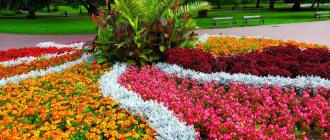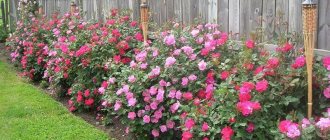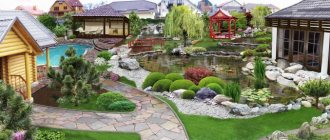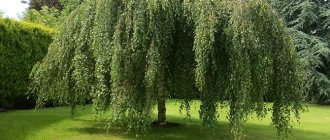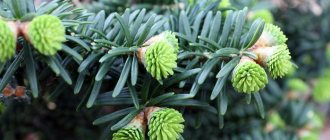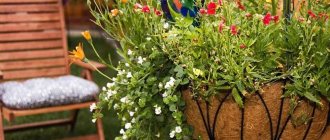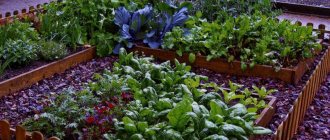When purchasing a plot of land and drawing up a plan for your future home, you definitely need to think about the placement of trees and shrubs, which are always planted first. This is explained not only by the size of the plants, but also by the relatively long period of growth before full flowering or fruiting. Of course, it is impossible to plant all the ornamental and fruit trees on a summer cottage due to the limited territory, so you have to choose.
And when deciding which trees to plant on a site, you need to focus on two principles:
- growing conditions: demanding or unpretentious species;
- main purpose, or place in the garden landscape (garden, hedge, single planting).
If we talk about fruit trees, apple trees require the simplest care (especially if you purchase a locally selected seedling that is resistant to common diseases and pests). Of course, unpretentious varieties do not have high taste, but they will not cause any trouble. But if you want to surprise your neighbors with something exotic, then you should think about planting yellow plum, actinidia, walnut or peach.
The same principle applies to ornamental trees and shrubs. For example, for a hedge you can use wild grapes, honeysuckle or drooping lilac, with minimal requirements for soil and climatic conditions, or you can decorate the area with juniper, barberry or hawthorn, which require a little more attention.
If you decide to plant a tree in your dacha, be sure to check the depth of the groundwater. Many trees, both fruit and ornamental, die as soon as their roots reach water. Such trees include the pear, which has a deeply penetrating root system. At first, the young seedling grows actively and pleases the owner, perhaps you will even be able to taste the first fruits, but then the tree begins to wither and dry up. Inexperienced gardeners complain about illness or poor-quality planting material and again buy and plant pear seedlings.
In order for tree plantings to truly become durable, it is necessary to take into account the requirements of each species for growing conditions.
Review of fruit trees and their features
Many people, having a summer cottage, want to plant fruit trees in the garden. For good fruiting, they require a high level of illumination, fertilizing, watering, pruning and preventive treatments against diseases and pests.
Blooming apple trees
Planting several varieties with the same ripening period has a beneficial effect on yield. To save space on the site, it is better to choose varieties with a compact crown shape on dwarf rootstocks. Below is a brief description of the main fruit crops according to the most significant parameters.
| Culture | Average life expectancy, years | Average tree height, m | Required power supply area, m | Preferred soils | Permissible depth of groundwater, m |
| Apple tree | from 20 to 50 | from 3 to 7 | 3x2 or 6x4 | slightly acidic | from 1 to 3 |
| Pear | 25 | 5 | 5x4 | any | 2 |
| Cherry | 25 | from 2 to 5 | 4x3 | neutral | 2 |
| Cherries | 60 | from 3 to 8 | 4x4 or 8x4 | neutral | 1,5 |
| Plum | 20 | 5 | 4x3 | neutral | 1,5 |
| Cherry plum | 20 | 2,5 | 3x3 | neutral | 1 |
| Apricot | 40-60 | from 5 to 10 | 5x6 | slightly alkaline | 2-2,5 |
| Kalina | 40 | 2,5 | 2x2 | slightly acidic | 1 |
| Irga | 50 | 2,5 | 3x2 | neutral | 1,5 |
| Honeysuckle | 20 | 1,5 | 2x1 | any | 1,5 |
| Sea buckthorn | 15 | from 3 to 5 | 2x2 | neutral | 1 |
| Rowan | 25 | 7 | 5x3 | slightly acidic | 2 |
| Hazel | 60 | 5 | 4x4 | slightly alkaline | 3 |
When choosing a fruit tree for a summer cottage, not only taste preferences, but also the climate zone play a big role. For example, chokeberry is recommended for the northern regions, as are honeysuckle and sea buckthorn, brought to central Russia from Siberia.
Rowan
Heat-loving cherry plums, plums, cherries and cherries are excellent in the southern regions. However, selection does not stand still and many crops adapt well to atypical regions thanks to their stable rootstock. An excellent example of this is Manchurian apricot and Siberian apricot, which are suitable for cultivation in Siberia and the Far East. And although such apricot has a specific, unattractive taste, it is quite successful in processing.
Manchurian apricot - mature tree
For rational use of the site, you can use grafting, which allows you to have several interesting varieties on one adult tree.
The relief of the site is the basis of construction
It rarely happens that a building area has a perfectly flat surface. There is always a certain level of slope and unevenness. The placement of the house should also be coordinated with the configuration of the site.
There are several options:
- The house is being built at the highest point of the territory, maintaining the distance from the boundaries of the site;
- Intensified excavation work is being carried out to completely level the territory and then build a cottage;
- The design and architecture fits organically into the landscape with minimal changes to the terrain. In this case, both the foundation and the house will have different levels, which will give the building a special charm and attractiveness.
Each approach has pros and cons, so only qualified design engineers and experienced builders can ensure compliance with the project, take into account your personal idea of comfort, and help you make the right choice.
The presence of green spaces will allow the creation of recreational areas without major innovations. Large trees can also protect a house from snow and wind in winter, and from sun and heat in summer. If you plan to plant trees to strengthen the soil, then it is worth remembering that deciduous trees take root best. But coniferous trees are more successful in creating a barrier to atmospheric phenomena. It is better to plant them from the prevailing or northern winds.
Overview of ornamental trees and shrubs
Decorative trees not only have an aesthetic function, but are often planted for shade near the gazebo, to protect against dust from the road, and to create a living border along the fence. Features of care depend on the type of plant and growing area.
Linden
There are trees that are undesirable to plant on a private plot because of aggressive growth or because of folk superstitions. Let's consider the most popular ornamental trees and shrubs in private landscape design from the point of view of their care and possible use.
Norway maple Globosum
| Culture | Short description | Usage | Note |
| Small-leaved linden | Tree up to 30 m high with a neat oval crown, high frost resistance, does not tolerate drought, the crown lends itself well to shaping | A shady tree with a pleasant fragrance during the flowering period, it is a honey plant, can be used for a hedge or planting along a fence, it holds dust well from the road | According to old sayings, the linden tree near the house protects against all diseases and illnesses. The young tree does not bloom, the first flowering is observed only in the 20-30th year of life, linden blossom is used in folk medicine |
| Norway maple | Tree up to 6 m high with a compact spherical crown, does not require frequent pruning, grows on any soil | Well suited for creating shade near a house or over an artificial pond, often planted along a fence or road | Used in folk medicine and cooking |
| Bird cherry | A tree from 4 to 10 m high, known for its snow-white racemose inflorescences with a bright aroma, undemanding to growing conditions | Due to the spreading wide crown, it is often planted singly at the edge of the plot or in alleys in a large garden. | It should not be planted close to the house, as its roots will destroy the foundation; produces edible fruits with medicinal properties |
| Poplar white (silver) | A fast-growing tree up to 30 m high with a spreading crown, has light bark and silver leaves, light-loving, salt-tolerant, tolerates drought and waterlogging, frost-resistant | Used in single or group plantings. For urban landscaping, pyramidal poplar is more often used, which does not form fluff, but has a large height. | It is not advisable to plant close to the house due to the aggressive root system; it cleans the air well of dust and harmful substances |
| Catalpa | A heat-loving tree 10-15 m high with a high spherical crown and an elegant, even trunk, the inflorescences are large, white, after flowering long pods are formed, giving additional decorativeness, does not tolerate pruning | Single plantings near the gazebo or near the house, during the flowering period it emits a very pleasant aroma, grows relatively slowly, may freeze in the Moscow region | People call it the “pasta tree” |
| Lilac | Abundantly flowering unpretentious shrub from 3 to 6 m high, the color of fragrant inflorescences is white or lilac in different shades, requires moderate pruning | Some varieties do not tolerate urban pollution, so it is not advisable to plant them near the road. Lilacs are ideal for hedges | It is popularly considered a protector of family well-being and a source of inspiration for creative people. |
| Barberry | A thorny shrub from 1 to 4 m high, with varied leaf colors (burgundy, yellow, green, purple), unpretentious in care | Used to create an impassable wall from dense thorny branches | Used in folk medicine, recommended for planting near home |
| Willow | A tree with drooping shoots, grows quickly, is easy to prune, tolerates significant waterlogging | Planting near water bodies or on waterlogged soils, hedges | A symbol of sadness and sadness, in the old days it was considered a bad omen to plant a willow tree under the window |
The list can go on for a long time, especially if we cover all the varieties and varieties. Breeders successfully cope with the task of “satisfying the needs of every gardener.”
Whether or not to plant a tree near the house is another important nuance
There is one more rule that concerns planting trees near the house. There is a popular belief that some plants should absolutely not be planted near human habitation.
Some plants have a special aura, which does not always have a beneficial effect on the fate and well-being of the owner of the house and his family members.
According to bioenergetics experts, the aura of a tree really affects the physical condition and emotional state of people, as well as their thoughts and well-being.
Plant energy researchers divide all trees into donors and so-called vampires.
The former take the negative energy of the people living in the house and transform it into positive. The latter only know how to absorb positive energy, so a person often feels a loss of strength, suffers from headaches and nightmares.
Trees that are undesirable in a garden plot according to ancient legends
Before planting a tree in front of your house, you can turn to the experience of our ancestors. At first glance, all signs are based on superstitions, but they often have a logical grain.
It is not recommended to plant an oak tree on a summer cottage, which has strong energy and influences the head of the family. Birch as a protective shield should only grow behind a fence. Walnuts should not be planted near the house, as their roots can eventually destroy the foundation. Willow, willow and aspen, the messengers of sorrow and death, are undesirable on the site.
If there are brides in the family, then it is also better to wait to plant thuja. It is recommended to plant poplar outside the site, away from the house.
Acacia
The tree feeds energy because it is a donor. Symbolizes purity, purity and rebirth. It promotes the birth of a new life, so it is recommended to plant it for couples who want to have a child.
In terms of energy, acacia is closer to women. It promotes peace, eliminates sadness and melancholy.
Overview of coniferous ornamental trees
Evergreen and fairly unpretentious conifers serve as an indispensable element of any garden design.
For small areas of summer cottages, Arizona fir with gray-blue needles (height up to 2 m) and balsam fir (dwarf variety) are suitable. For those who want to grow a large tree, Korean fir (up to 15 m) is suitable.
Korean fir Silberlock
Dwarf varieties reaching a height of up to 3 m include Atlas cedar and Himalayan cedar. Among the large trees, Siberian cedar (cedar pine) enjoys well-deserved popularity. It grows slowly, but reaches very impressive sizes.
Siberian cedar (cedar pine)
Larch and spruce often decorate country houses with a large garden area. There are varieties of standard larch with a height of no more than 2.5 m with a spherical or weeping crown. Varieties of weeping larch look very impressive: the European dwarf variety Repens, up to 1.5 m high, with branches almost creeping along the ground, and the Japanese variety Pendula, up to 7 m high, with delicate green-blue needles.
Japanese larch Pendula
Dwarf forms of spruce can reach a height of 2 - 2.5 m, which, with slow growth, becomes acceptable in areas of any size. There are many varieties of dwarf spruce with different colored needles and different crown shapes. Blue spruce trees look the most beautiful and original, standing out effectively among the rest of the vegetation.
Blue spruce Hoopsie
Coniferous shrubs with different crown shapes include yew and juniper. In the landscape design of private plots, dwarf species of juniper with different colored needles (from dark green to silver-blue) up to 8 m in height are used.
Timing of tree planting and purchase of seedlings
It is difficult to unequivocally answer the question of when is the best time to plant trees. It depends on weather conditions and the specific crop. The optimal time for planting fruit trees from the pome group is late autumn, and for heat-loving stone fruits it is better to plant them in early spring. The preferred age of seedlings is 2 years, but for vigorous crops (pear, cherry) it is better to use annual seedlings. The negative side of annual seedlings is their unformed crown, but they suffer less pain when transplanted and take root faster.
Most ornamental crops are planted in spring. Moreover, the strict limits “before bud break” apply only to seedlings with an open root system. Planting material with a closed root system (in pots or bags) is suitable for planting throughout the spring and even in summer, but it is more expensive.
When purchasing seedlings at specialized exhibitions and fairs, you need to pay attention to the following points:
- in what form they are sold: seedlings with exposed and dried roots have little chance of taking root on the site; good material is packed in bags with a small lump of damp earth;
- condition of the root system: roots should be smooth (without thickening), elastic and without signs of peeling;
- crown condition: the buds should be swollen, but not bloomed;
- trunk height: for 2-year-old fruit seedlings about 50 cm;
It is recommended to buy planting material from nurseries that exist in each region. Only there can you be sure of the quality of the seedlings and choose plants adapted for a specific zone. Varieties of fruit trees for the Moscow region and the entire central zone of Russia are grown in the Michurinsky fruit nursery.
How to peacefully resolve a conflict?
Situations when owners of their land plots erect residential and non-residential buildings too close to neighboring territories, violating existing norms (even out of ignorance), are in fact not at all uncommon. And in this case, neighbors can (and do) turn to the courts. And in order to prevent this, it is worth trying to come to an agreement peacefully.
With many, by the way, it’s really “easy to come to an agreement” (this once again demonstrates how important it is to maintain good relationships with those who live nearby). Others need to be offered compensation (this is almost always much cheaper than demolishing and moving something)
With the third, try to find some other compromise. You must act according to the situation and circumstances. The main thing is to draw up a settlement agreement and have it notarized. Only this will somehow secure the illegal (in terms of required distances) construction.
Important: if a peaceful agreement cannot be reached, you need to turn to the rules that were previously in force in the country. Suddenly, what was built too close was built absolutely legally at that time
Then maybe this is not a violation at all. The law does not have retroactive force. In general, you need to use all possible methods.


